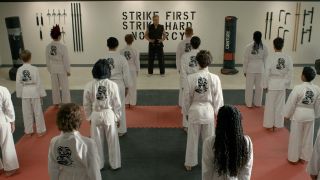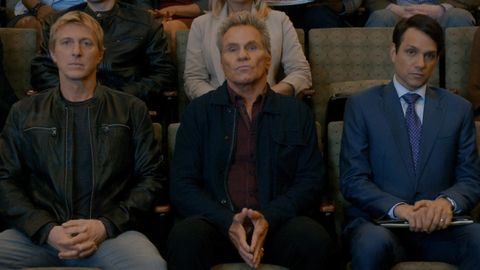GamesRadar+ Verdict
Despite flagging in its early stages, Cobra Kai season 3 eventually hits its stride with a pulsating run of episodes that pays tribute to the past while setting the show up for a flourishing future
Why you can trust GamesRadar+
Cobra Kai season 3 dares to be different. The first two series drew us in with love triangles, high school hijinks, and heartfelt callbacks to the Karate Kid movies. While much of that remains, it’s clear that Cobra Kai – now a Netflix original series – is more confident in its own gi. What was once a fun, throwaway series has finally proven itself capable of earning a boxset black belt thanks to more emotional heft and a superb second half – one which will inevitably cement this season’s place among the best shows of 2021.
Season 3, though, takes some time getting over the events of last season. The fallout from Miguel’s fateful fall takes centre stage in the opening, at the show’s detriment. Cobra Kai is more preoccupied with clumsily providing a catch-up for lapsed fans. Much of the premiere provides endless reminders and explainers on why certain people are MIA rather than offering any real narrative thrust – a puzzler after how things left off.
Miguel, so often the heart and focus of the show, is sidelined for part of Cobra Kai season 3. The series ponders a future with multiple protagonists to mixed results. Some step forward and fill in the vacuum to good effect, but the experiment doesn’t completely pay off due to the fact we’ve spent so much time with Miguel through the first two seasons. There’s always a gnawing, aching gap waiting to be filled by Johnny’s student.

But things rapidly improve. Cobra Kai and Miyagi-do have a lot of unfinished business left on the dojo mats, after all. Much of the season sees the two factions wage war, with the interlocking rivalry between Cobra Kai’s Kreese, Johnny Lawrence, and Daniel LaRusso threatening to bubble over. It all builds up to a climatic crescendo, one that ranks among the wildest, most ridiculously fun 40 minutes of television that’s aired these past few years.
This isn’t the same Cobra Kai that streamed on YouTube Red. The move to Netflix may not have changed much in terms of production (season 3 was filmed long before the move), but it’s instantly striking how different things feel. There’s a darker edge that, to the show’s credit, goes further than in prior seasons. Don’t expect Game of Thrones-style Red Weddings, though there are similarly frequent stomach knots as the walls close in around several characters. That sense of peril only improves the show – but never loses sight of what brought them to the dance.
It’s easy to forget, amid the dojo duelling and teenage angst-fuelled antics, just how funny Cobra Kai is. The levity often comes courtesy of William Zabka’s Johnny Lawrence, who delivers a deep, multi-faceted performance that ranks as the show’s very best. It’s a testament to the actor that he can spend one episode ogling Playboy centerfolds and wracked with guilt and slumping around with those lost, heavy sea-blue eyes the next without any feeling of disconnect.

There is, though, a sense of uneasiness. The writers challenge themselves by placing each of the leads in more penned-in positions to the ones they’re usually used to. Sam crumbles; Miguel falters; Robby scowls – OK, that last one isn’t too different. Sometimes it misses the mark, but the shake-up in dynamics undeniably keeps things fresh where a lesser show would have been content to continue the formula and grow stale. Better still, it allows the new generation to sink its teeth into juicier material and thrive under a greater amount of screen time. It’s night and day from the high school drama that veered into 90210-lite territory, especially in the first season.
Of course, Cobra Kai isn’t all forward-thinking. For most Karate Kid fans, the high points of the season will undoubtedly revolve around more reverential detours. Daniel’s departure midway through the season to the Japanese island of Okinawa may seem to be a shoehorned-in dose of nostalgia at first glance. Yet, the literal distance that separates LaRusso from the action presents a different side to Cobra Kai, one that definitively deals with the show’s inescapable ties to the past. In this case, The Karate Kid Part 2 gets its latter-day moment in the sun – and finally puts a button on relationships decades after the fact.
Throughout all the bluster and badass fights that punctuate the show’s run, it’s ultimately at its best when it stops and takes a minute to breathe. This is best seen when Daniel and former love interest Kumiko have a heart-to-heart in Japan. It’s a moment – alongside another returning familiar face – that showcases Cobra Kai’s strengths and uses nostalgia as a tool to keep things moving forward. It’s a smart evolution from the sometimes flashback-heavy setups in years gone by.
It’s clear, then, that Cobra Kai season 3 is comfortable treading on new ground. Even when several major characters find themselves in unfamiliar territory, the show ultimately powers through and delivers its best season yet. Yes, it takes a few episodes for Cobra Kai to find its footing, but the Netflix series refines the show’s trademark OTT karate drama, while also revelling in a riskier, darker season – one that packs a punch for new and old fans alike.
I'm the Senior Entertainment Writer here at GamesRadar+, focusing on news, features, and interviews with some of the biggest names in film and TV. On-site, you'll find me marveling at Marvel and providing analysis and room temperature takes on the newest films, Star Wars and, of course, anime. Outside of GR, I love getting lost in a good 100-hour JRPG, Warzone, and kicking back on the (virtual) field with Football Manager. My work has also been featured in OPM, FourFourTwo, and Game Revolution.

